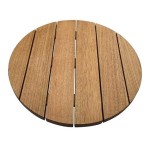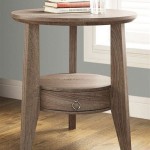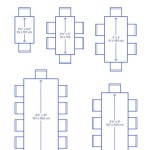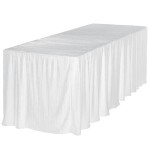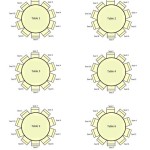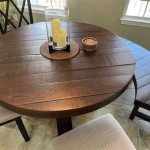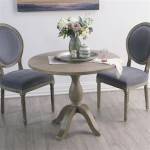Should Placemats Be Left on the Table?
The question of whether to leave placemats on the table when not in use is a recurring one in both domestic and commercial settings. There is no single correct answer, as the suitability of this practice depends on a variety of factors, ranging from aesthetics and functionality to the type of table surface and the intended purpose of the space. A careful evaluation of these considerations is necessary to make an informed decision.
This article explores the advantages and disadvantages of leaving placemats on the table, examining the potential impact on table preservation, the role of placemats in interior design, and the practical implications for daily use. By considering these aspects, readers can develop a comprehensive understanding of the subject and determine the most appropriate approach for their specific circumstances.
Protecting the Table Surface
One of the primary functions of placemats is to protect the table surface from damage. Hot dishes, condensation from cold beverages, and accidental spills can all mar or stain a table, particularly if it is made of wood or another porous material. Leaving placemats on the table, even when a meal is not being served, provides a continuous barrier against these potential hazards. This constant protection can be especially beneficial in households with young children or in commercial environments where tables are subject to frequent use and potential accidents.
However, the effectiveness of placemats in protecting the table surface depends on the material of both the placemat and the table. Placemats made of porous materials, such as fabric, may absorb spills and allow them to seep through to the table below. Similarly, abrasive placemats can scratch delicate table surfaces. It is crucial to select placemats that are appropriate for the specific table material and the types of activities that typically occur at the table.
Furthermore, trapped moisture can become a concern if placemats are left on the table for extended periods, particularly under humid conditions. Moisture can accumulate between the placemat and the table surface, potentially leading to the growth of mold or mildew. To mitigate this risk, it is advisable to occasionally lift the placemats to allow for air circulation. This is especially important for tables made of wood, which is susceptible to moisture damage.
Choosing the right type of placemat is therefore critical for effective protection. Heat-resistant placemats are essential for preventing damage from hot dishes, while waterproof placemats are ideal for preventing stains from spills. The material of the placemat should also be non-abrasive to avoid scratching the table surface. Regular cleaning of placemats is also important to remove any food particles or spills that could attract pests or contribute to the growth of mold or mildew.
Aesthetic Considerations and Interior Design
Beyond their functional role, placemats contribute to the overall aesthetic of a dining area. They can serve as decorative accents, adding color, texture, and visual interest to the table setting. Leaving placemats on the table when not in use can maintain a polished and inviting atmosphere, enhancing the room's decor. The choice of placemat design, color, and material can complement the existing style of the room, whether it is modern, traditional, or eclectic.
However, the aesthetic impact of leaving placemats on the table is subjective and depends on individual preferences. Some individuals may prefer a minimalist look with a bare table, while others may appreciate the added visual appeal of placemats. The decision should be based on the desired aesthetic and the overall design of the space. It is also important to consider the potential for placemats to clash with other decorative elements in the room.
The arrangement of placemats on the table can also influence the overall aesthetic. Placemats can be arranged symmetrically for a formal look or asymmetrically for a more casual feel. The size and shape of the placemats should also be appropriate for the size and shape of the table. Oversized placemats can overwhelm a small table, while undersized placemats may appear insignificant on a large table.
Seasonal changes can also influence the decision of whether to leave placemats on the table. During the holidays, festive placemats can add to the celebratory atmosphere. In the summer, bright and colorful placemats can evoke a sense of warmth and vibrancy. Changing placemats seasonally can be a simple and effective way to update the look of a dining area without making major changes to the decor.
Practical Implications for Daily Use
The decision of whether to leave placemats on the table also has practical implications for daily use. Leaving placemats on the table can save time and effort by eliminating the need to set the table before each meal. This can be particularly convenient for individuals who lead busy lives or who frequently eat meals at the table. It can also be beneficial in commercial settings, such as restaurants, where quick table turnaround is essential.
Conversely, leaving placemats on the table can make it more difficult to clean the table surface. Crumbs and spills can accumulate under the placemats, requiring them to be lifted and cleaned frequently. This can be particularly problematic if the placemats are made of a material that is difficult to clean. In some cases, it may be easier to simply wipe down the bare table surface after each meal.
The presence of placemats on the table can also influence the way the table is used for other activities. For example, if the table is used for working, studying, or playing games, the placemats may need to be removed to provide a smooth and unobstructed surface. In these situations, it may be more practical to store the placemats when they are not needed for dining.
The frequency of table use is also a relevant factor. If the table is used frequently for meals, leaving placemats on the table may be more convenient. However, if the table is used infrequently, the placemats may simply collect dust and become a visual clutter. In these situations, it may be more appropriate to store the placemats until they are needed.
Ultimately, the decision of whether to leave placemats on the table is a personal one that should be based on a careful consideration of the factors discussed above. There is no one-size-fits-all answer, and the best approach may vary depending on the individual's lifestyle, aesthetic preferences, and the specific characteristics of the table and placemats.

How To Use Placemats Ultimate Style Guide French Affair

How To Use Placemats Ultimate Style Guide French Affair

How To Set The Table With Placemats

How To Use Placemats Ultimate Style Guide French Affair

How To Style A Dining Room Table

Do You Put Placemats On Top Of A Table Runner Sastybale

How To Style A Dining Room Table

Dress Up Your Dinner Table Setting With Beautiful Place Mats Times Of

7 Ways To Set A Table With Natural Fiber Placemats Calypso In The Country

Table Runners And Placemats
Related Posts

